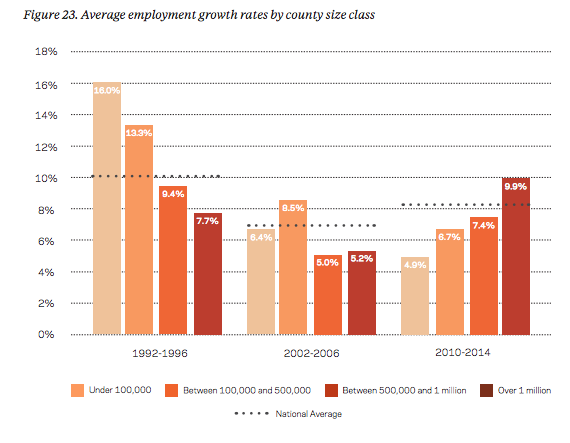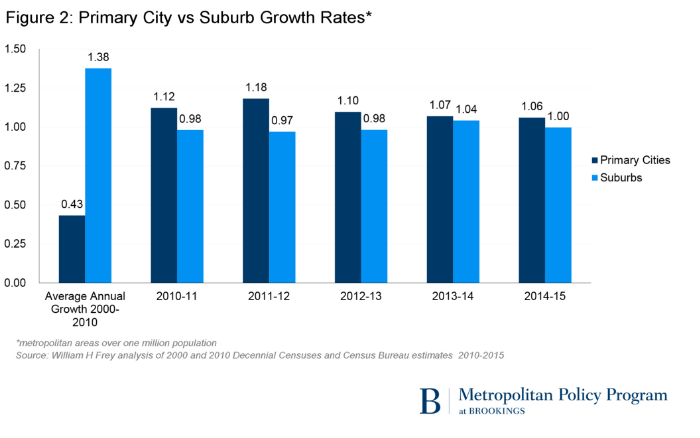A trio of reports released in the past week provide new data showing the economic strength of the nation’s cities.
Whether we look at population growth, new business formation, or job creation, big cities, urban centers and close-in urban neighborhoods are big drivers of national growth. While the data are drawn from different sources and use slightly different geographies, the messages are quite similar.
The Economic Innovation Group, a Washington-based think tank, used county-level data from the Census Bureau’s County Business Patterns program to chart net new business formation and job growth. Over the period 2010-2014, the 20 counties with the largest increase in new businesses (all big urban counties) accounted for a majority of all net new business formation in the current economic expansion. The 20 counties with the largest job increases accounted for 28 percent of all new jobs. This represents a dramatic turnaround from previous expansions in the 1990s and early 2000s, when smaller, less populous counties tended to grow faster. The dwindling rate of new firm formation is a topic of growing concern as we think about the nation’s long term growth prospects; in the current recovery, a few large metropolitan areas have played a dramatically disproportionate role in fueling new business activity.

In the 1990s, there was a strong negative correlation between county population and job growth rates, meaning that less populous counties grew much faster than more populous ones. But in the past four years, that relationship has reversed. Small counties are growing the most slowly; larger counties are growing more rapidly. Counties with a million or more residents grew only half as fast as those with fewer than 100,000 residents in the mid-90s (7.7 percent vs. 16 percent); and the larger counties grew more than twice as fast (9.9 percent vs 4.4 percent) since 2010.
The Brookings Institution’s Bill Frey crunched the numbers from the latest (2015) Census population estimates to track population growth in the nation’s 50 largest metropolitan areas, comparing growth rates in the principal city in each metropolitan area, with the remaining jurisdictions. As Frey notes, principal cities—the largest municipality in each metropolitan area—are growing faster than the remaining portion of metropolitan areas, reversing a long-standing pattern of suburban growth outpacing city growth. Cities have grown faster than suburbs since 2010.

And at City Observatory, we’ve released our updated figures on central city job growth. Using fine-grained establishment level data from the Census Bureau’s Local Employment and Housing Dynamics (LEHD) database, we’ve plotted employment change for the three mile radius surrounding the center of the central business district in the nation’s large metropolitan areas. While job growth in urban centers lagged well behind suburbs a decade ago, job growth rates urban centers are today very similar to those in more suburban locations. Bloomberg View columnist Justin Fox addressed the findings of our report in a recent column, and highlighted the pattern of change over time:

While these three reports draw on different data sources, and use somewhat different geographies (large counties, principal cities and a three-mile radius) they tell very similar stories about the persistence of urban-led population and economic growth in the US at least through the middle of the present decade.
More jobs, more businesses, more people. These three reports add to a growing body of data suggestion that large metropolitan areas and urban centered economies are increasingly driving national economic prosperity.
As we’ve noted before, using city and county boundaries to measure differences between “cities” and “suburbs” and particularly to make comparisons across metropolitan areas can be problematic. City and county boundaries often don’t correspond well to patterns of urbanization, and the scope of a largest county or principal city varies widely across metropolitan areas.
